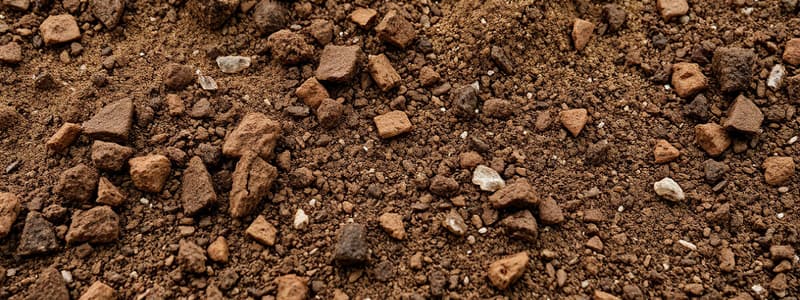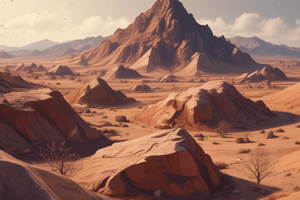Podcast
Questions and Answers
Which soil particle is the largest and can be seen with the naked eye?
Which soil particle is the largest and can be seen with the naked eye?
- Sand (correct)
- Silt
- Clay
- Organic matter
What is the texture of soil high in clay when it is dry?
What is the texture of soil high in clay when it is dry?
- Gritty
- Hard (correct)
- Smooth
- Floury
Which statement accurately describes silt partices?
Which statement accurately describes silt partices?
- They are similar in size to bacterium and only visible with a microscope.
- They are about the size of individual particles of white flour. (correct)
- They have a flat shape similar to sheets of mica.
- They are smaller than sand and give soil a gritty feel.
What percentage of soil is ideally comprised of pore space?
What percentage of soil is ideally comprised of pore space?
What role do soil organisms play in the ecosystem?
What role do soil organisms play in the ecosystem?
Why do clay particles feel different when moist compared to when dry?
Why do clay particles feel different when moist compared to when dry?
Which statement is true about clay particles?
Which statement is true about clay particles?
What benefit does soil provide to plants?
What benefit does soil provide to plants?
What is the primary characteristic of soil with mostly macropores?
What is the primary characteristic of soil with mostly macropores?
How does excess wetness in soils with mostly micropores affect plant growth?
How does excess wetness in soils with mostly micropores affect plant growth?
Which of the following factors does NOT affect soil porosity?
Which of the following factors does NOT affect soil porosity?
What tools can be used to evaluate garden soil properties?
What tools can be used to evaluate garden soil properties?
Soil texture is determined by the relative abundance of which materials?
Soil texture is determined by the relative abundance of which materials?
Which statement is true regarding soils with mostly micropores?
Which statement is true regarding soils with mostly micropores?
What particle size defines gravel in soil classification?
What particle size defines gravel in soil classification?
What is the effect of human activity on soil properties?
What is the effect of human activity on soil properties?
Soils with a high amount of macropores are ideal for retaining water.
Soils with a high amount of macropores are ideal for retaining water.
Micropores in soil provide water that is accessible to plant roots.
Micropores in soil provide water that is accessible to plant roots.
Soil texture refers to the size of soil particles including sand, silt, and clay.
Soil texture refers to the size of soil particles including sand, silt, and clay.
Soil that is too wet can lead to improved plant growth.
Soil that is too wet can lead to improved plant growth.
Gravel is considered soil if its particles are smaller than two millimeters.
Gravel is considered soil if its particles are smaller than two millimeters.
Human activity has no impact on soil porosity.
Human activity has no impact on soil porosity.
A well-balanced soil contains both macropores and micropores.
A well-balanced soil contains both macropores and micropores.
The tools needed to evaluate garden soil properties include only a shovel and a pencil.
The tools needed to evaluate garden soil properties include only a shovel and a pencil.
The coarsest soil particles are silt.
The coarsest soil particles are silt.
Clay particles are the largest type of soil particle.
Clay particles are the largest type of soil particle.
Soil is a mixture of weathered rock fragments and organic matter.
Soil is a mixture of weathered rock fragments and organic matter.
An ideal soil should be made up of 50 percent pore space.
An ideal soil should be made up of 50 percent pore space.
Silt particles can be seen with the naked eye.
Silt particles can be seen with the naked eye.
Soils with high clay content feel very hard when dry.
Soils with high clay content feel very hard when dry.
Soil organisms play a role in recycling dead cells and tissues into nutrients.
Soil organisms play a role in recycling dead cells and tissues into nutrients.
Clay particles are shaped like individual grains of sand.
Clay particles are shaped like individual grains of sand.
The coarsest soil particles are ______.
The coarsest soil particles are ______.
Silt particles are about the size of individual particles of ______.
Silt particles are about the size of individual particles of ______.
Clay particles can be seen only with a ______.
Clay particles can be seen only with a ______.
Soil provides nutrients, water, and physical support for ______.
Soil provides nutrients, water, and physical support for ______.
An ideal soil is roughly 50 percent ______ space.
An ideal soil is roughly 50 percent ______ space.
Soils high in clay feel very hard when ______.
Soils high in clay feel very hard when ______.
Soil organisms act as nature’s primary ______, recycling dead cells into nutrients.
Soil organisms act as nature’s primary ______, recycling dead cells into nutrients.
When moist, clay soil is easily shaped and ______.
When moist, clay soil is easily shaped and ______.
Soil that has a balance of macropores and micropores provides adequate ______ and water-holding capacity for good plant growth.
Soil that has a balance of macropores and micropores provides adequate ______ and water-holding capacity for good plant growth.
Soils that contain mostly ______ drain readily but are droughty and need more frequent irrigation.
Soils that contain mostly ______ drain readily but are droughty and need more frequent irrigation.
Soils that contain mostly micropores have good water-holding capacity but take longer to ______ out.
Soils that contain mostly micropores have good water-holding capacity but take longer to ______ out.
Soil texture describes the relative abundance of sand, silt, and ______-sized materials.
Soil texture describes the relative abundance of sand, silt, and ______-sized materials.
Anything greater than two millimeters in size is considered ______ or rock and is not soil.
Anything greater than two millimeters in size is considered ______ or rock and is not soil.
Soil texture, structure, organic matter, and human activity affect ______.
Soil texture, structure, organic matter, and human activity affect ______.
Excessive wetness in soil can lead to reduced ______ growth.
Excessive wetness in soil can lead to reduced ______ growth.
The only tools you need to evaluate your garden soil are your ______, fingers, and a shovel.
The only tools you need to evaluate your garden soil are your ______, fingers, and a shovel.
Flashcards are hidden until you start studying
Study Notes
Soil Composition
- Soil consists of weathered rock fragments and organic matter found at the earth's surface.
- Composed primarily of three particle sizes: sand, silt, and clay.
Particle Size Characteristics
- Sand:
- Coarsest soil particle, visible to the naked eye.
- Provides a gritty texture to soil.
- Silt:
- Smaller than sand, akin to individual flour particles.
- Gives soil a smooth, floury feel.
- Clay:
- Finest soil particle size, comparable to bacteria and viruses.
- Visible only through a microscope, has a flat shape resembling mica.
- Feels hard when dry and easily moldable when moist.
Soil Structure and Properties
- Ideal soil comprises approximately 50% pore space, necessary for aeration and water retention.
- Pores in soil create a network influencing its drainage and moisture retention capabilities.
Soil Functionality
- Acts as a habitat for microorganisms, invertebrates, and plant roots, supporting biological activity.
- Provides essential nutrients, water, and physical support for plant life.
- Soil organisms recycle dead organic material into usable nutrients, energy, carbon dioxide, and water for new life.
Water Retention in Soil
- Micropores hold water available to plants, while some water remains too tightly held for root access.
- Balanced pore size distribution enhances soil's drainage and water-holding capacity.
- Soils dominated by macropores tend to drain quickly but require frequent irrigation due to droughtiness.
- Soils primarily made up of micropores retain more water but can lead to excessive wetness, hindering plant growth.
Evaluating Soil Quality
- Soil texture refers to the balance of sand, silt, and clay present.
- Organic matter, soil structure, and human activities influence porosity.
- Soil evaluation can be performed using simple tools: eyesight, fingers, and a shovel.
Soil Texture Definition
- Anything greater than two millimeters in size is classified as gravel or rock, thus not considered soil.
Soil Composition
- Soil consists of weathered rock fragments and organic matter found at the earth's surface.
- Composed primarily of three particle sizes: sand, silt, and clay.
Particle Size Characteristics
- Sand:
- Coarsest soil particle, visible to the naked eye.
- Provides a gritty texture to soil.
- Silt:
- Smaller than sand, akin to individual flour particles.
- Gives soil a smooth, floury feel.
- Clay:
- Finest soil particle size, comparable to bacteria and viruses.
- Visible only through a microscope, has a flat shape resembling mica.
- Feels hard when dry and easily moldable when moist.
Soil Structure and Properties
- Ideal soil comprises approximately 50% pore space, necessary for aeration and water retention.
- Pores in soil create a network influencing its drainage and moisture retention capabilities.
Soil Functionality
- Acts as a habitat for microorganisms, invertebrates, and plant roots, supporting biological activity.
- Provides essential nutrients, water, and physical support for plant life.
- Soil organisms recycle dead organic material into usable nutrients, energy, carbon dioxide, and water for new life.
Water Retention in Soil
- Micropores hold water available to plants, while some water remains too tightly held for root access.
- Balanced pore size distribution enhances soil's drainage and water-holding capacity.
- Soils dominated by macropores tend to drain quickly but require frequent irrigation due to droughtiness.
- Soils primarily made up of micropores retain more water but can lead to excessive wetness, hindering plant growth.
Evaluating Soil Quality
- Soil texture refers to the balance of sand, silt, and clay present.
- Organic matter, soil structure, and human activities influence porosity.
- Soil evaluation can be performed using simple tools: eyesight, fingers, and a shovel.
Soil Texture Definition
- Anything greater than two millimeters in size is classified as gravel or rock, thus not considered soil.
Soil Composition
- Soil consists of weathered rock fragments and organic matter found at the earth's surface.
- Composed primarily of three particle sizes: sand, silt, and clay.
Particle Size Characteristics
- Sand:
- Coarsest soil particle, visible to the naked eye.
- Provides a gritty texture to soil.
- Silt:
- Smaller than sand, akin to individual flour particles.
- Gives soil a smooth, floury feel.
- Clay:
- Finest soil particle size, comparable to bacteria and viruses.
- Visible only through a microscope, has a flat shape resembling mica.
- Feels hard when dry and easily moldable when moist.
Soil Structure and Properties
- Ideal soil comprises approximately 50% pore space, necessary for aeration and water retention.
- Pores in soil create a network influencing its drainage and moisture retention capabilities.
Soil Functionality
- Acts as a habitat for microorganisms, invertebrates, and plant roots, supporting biological activity.
- Provides essential nutrients, water, and physical support for plant life.
- Soil organisms recycle dead organic material into usable nutrients, energy, carbon dioxide, and water for new life.
Water Retention in Soil
- Micropores hold water available to plants, while some water remains too tightly held for root access.
- Balanced pore size distribution enhances soil's drainage and water-holding capacity.
- Soils dominated by macropores tend to drain quickly but require frequent irrigation due to droughtiness.
- Soils primarily made up of micropores retain more water but can lead to excessive wetness, hindering plant growth.
Evaluating Soil Quality
- Soil texture refers to the balance of sand, silt, and clay present.
- Organic matter, soil structure, and human activities influence porosity.
- Soil evaluation can be performed using simple tools: eyesight, fingers, and a shovel.
Soil Texture Definition
- Anything greater than two millimeters in size is classified as gravel or rock, thus not considered soil.
Studying That Suits You
Use AI to generate personalized quizzes and flashcards to suit your learning preferences.



